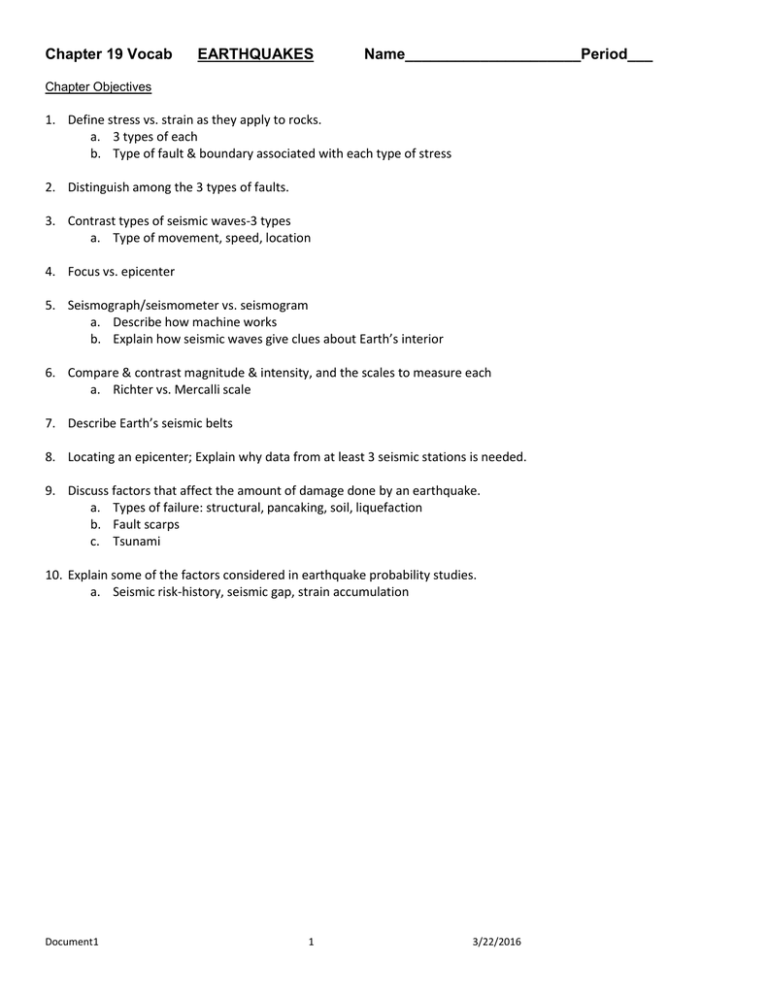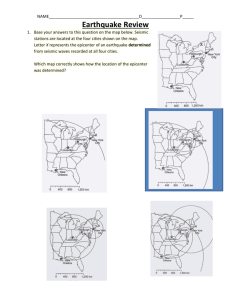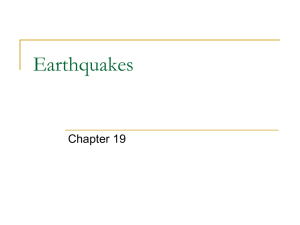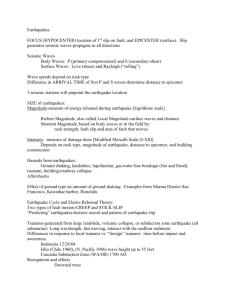File
advertisement

Chapter 19 Vocab EARTHQUAKES Name_____________________Period___ Chapter Objectives 1. Define stress vs. strain as they apply to rocks. a. 3 types of each b. Type of fault & boundary associated with each type of stress 2. Distinguish among the 3 types of faults. 3. Contrast types of seismic waves-3 types a. Type of movement, speed, location 4. Focus vs. epicenter 5. Seismograph/seismometer vs. seismogram a. Describe how machine works b. Explain how seismic waves give clues about Earth’s interior 6. Compare & contrast magnitude & intensity, and the scales to measure each a. Richter vs. Mercalli scale 7. Describe Earth’s seismic belts 8. Locating an epicenter; Explain why data from at least 3 seismic stations is needed. 9. Discuss factors that affect the amount of damage done by an earthquake. a. Types of failure: structural, pancaking, soil, liquefaction b. Fault scarps c. Tsunami 10. Explain some of the factors considered in earthquake probability studies. a. Seismic risk-history, seismic gap, strain accumulation Document1 1 3/22/2016 SECTION 19.1 FORCES WITHIN EARTH K (What You Need to KNOW ) 1. Stress 2. Strain 3. Elastic Strain 4. Ductile Deformation 5. Failure (as it pertains to rocks) 6. Fault 7. Normal Fault 8. Reverse Fault Document1 I (Information) 2 M (Memory Clue) 3/22/2016 9. Strike-slip Fault 10. Tension 11. Compression 12. Shear 13. Primary Waves (P-Waves) 14. Secondary Waves (S-Waves) 15. Surface Waves 16. Focus 17. Epicenter Document1 3 3/22/2016 Section 19.2 SEISMIC WAVES & EARTH’S INTERIOR 18. Figure 19-10 p. 503 shows the path of earthquake waves as they travel through Earth: a. Which type of wave, P-wave or S-wave, does not travel through the core? b. Reading the caption below the diagram, why can’t they go through the outer core? c. What happens to the other type of wave when it moves from the core to the mantle and vice versa? 19. Seismometer (AKA Seismograph) 20. Seismogram 21. Refraction 22. Shadow Zone 23. Earth’s Interior (Layers) Document1 4 3/22/2016 Section 19.3 MEASURING AND LOCATING EARTHQUAKES 24. Use Table 19-1 Modified Mercalli Intensity Scale on p.507: You are in your house when suddenly both the front room window and front room wall cracks. What level (Roman numeral number) of earthquake intensity are you feeling? 25. Use Figure 19-14 p.509: How many seismic stations are needed to determine the epicenter of an earthquake? 26. Figure 19-15 p. 510 shows the locations of earthquake epicenters. Their locations tend to be form lines along the edges of something else we have studied this year. They tend to be along the edges of what? 27. Magnitude 28. Richter Scale 29. Intensity 30. Modified Mercalli Scale 31. Locating an Earthquake Epicenter Section 19.4 EARTHQUAKES & SOCIETY 32. Figure 19-19 p. 514 shows the areas of the United States that have both high risk and low risk of having an earthquake. Locate Iowa. What category of risk are we in? Document1 5 3/22/2016 33. Pancaking 34. Liquefaction 35. Fault Scarp 36. Tsunami 37. Seismic Risk 38. Seismic Gap 39. Strain Accumulation Common Concepts/Overriding Goals for Every Unit throughout the Year: 1. 2. 3. 4. Humans impact the environment around them in profound ways Form is intimately tied to function Scientists use technology to find out about the world around them Scientists engage in inquiry to find out around the world around them. Document1 6 3/22/2016









